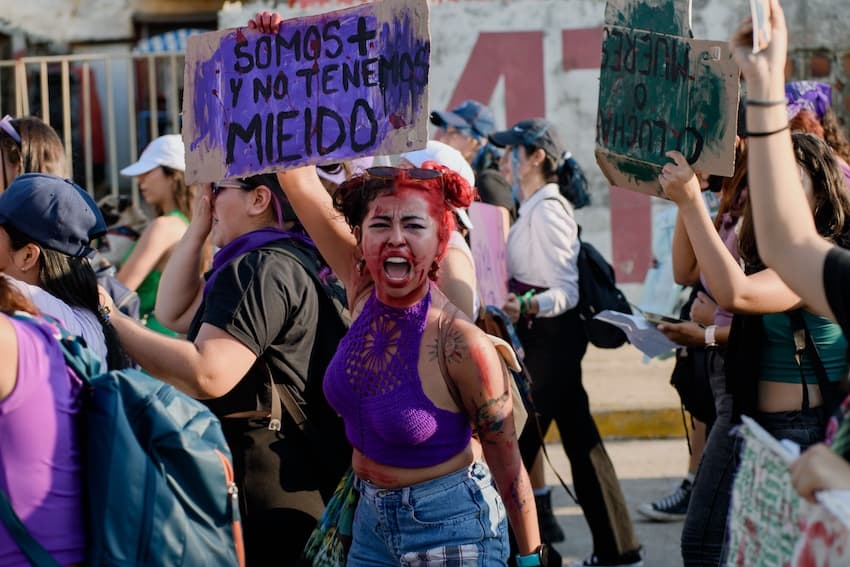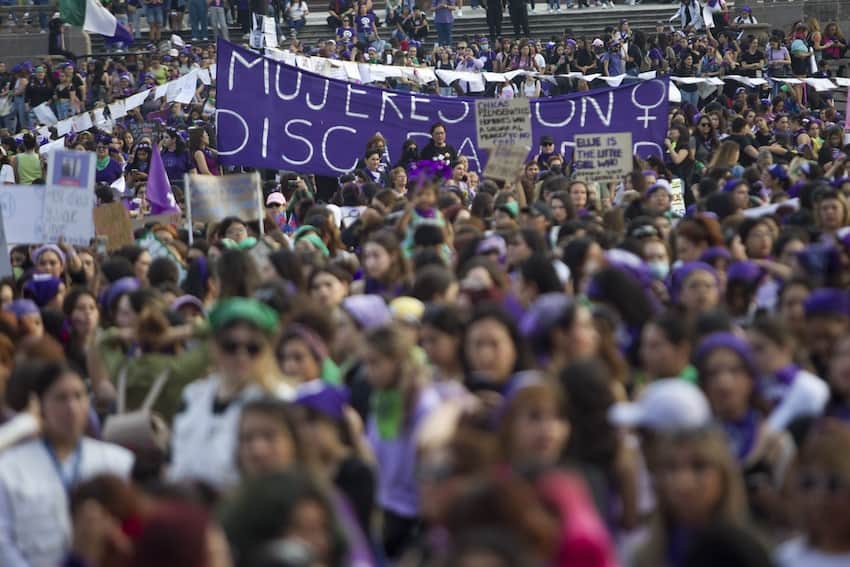On March 9, 2020, women all over Mexico did not go to work, stayed home, made no purchases and urged all their female friends and family to do the same. This strike, referred to as “Un Día Sin Nosotras” (A Day Without Us), was organized in response to the rise in femicide rates in 2019, a year that saw between 10 and 15 women killed in gender-based hate crimes every day.
International Women’s Day, celebrated a day earlier, was marked by extra fervor that year: the march in Mexico City gathered over 80,000 people and lasted around 8 hours. There was collective anger in the air, targeted specifically at authorities’ lack of action concerning justice for victims of femicide.

For Latin American feminists, International Women’s Day represents solidarity and resistance. It also goes by a shorter, simpler name: 8M, pronounced “ocho eme.” The month of March is all purple and green, and every day leading up to the 8th is a buzz of anticipation. The color purple has symbolized the feminist fight since the English suffragettes of the Women’s Social and Political Union used it in the 1900s, next to a green and white color scheme. In Latin America, green also represents the “marea verde” (green tide), a common name for the regional abortion-rights movement that originated in Argentina. In recent years, some feminists have added pink to signify solidarity with trans women.
In Mexico, the strike of 2020 had an economic impact of 30 million pesos (US $1.8 million), despite the fact that only 10% of women participated in it. However, the social and psychological impact it had on women of all socioeconomic levels in Mexico was unprecedented.
For many, especially those from more conservative and privileged backgrounds, the strike was hard to understand. For them, a day like International Women’s Day is considered a celebration, rather than a politicized event. Why should they stop going to work? How come they had to give their female employees the day off? Why are feminists so upset, so incendiary, and why are they graffitiing national monuments? For some, it seemed like the first time they confronted the harsh reality that women in underserved and underprivileged communities face every single day. Some started to understand why we don’t “celebrate” 8M. Whether they participated in the 2020 strike or not, many later joined the march the following year, amidst the COVID-19 pandemic.
The feminist movement has quickly become one of the most active political forces in Mexico. This means that political parties, corporations and special interest groups have taken it upon themselves to try and represent it. This is an impossible feat, of course, since the only people who can truly represent a movement like feminism are those who have nothing to gain from it but a better world and a more just society.

Putting political and corporate interests aside, the strike of 2020 and the four 8Ms that followed since have undoubtedly paved the way for more inclusive, cooperative and community-oriented relationships between women.
The Women’s Day marches of 2022 and 2023 in Mexico City had over 10,000 more attendees than the prior years, close to 90,000 people. Ateneas — female officers of the Mexico City police deployed at protests in the capital — wore purple vests instead of blue to honor the cause of the march. This March marks another year where women and allies will unite to form organized marching blocs to protest safely together. Social media is filled with listings for different marches, events and other opportunities allowing women and their allies to get together throughout the week, and the days after International Women’s Day.
Additionally, there has been an important material change in Mexico: for the first time ever, half of all federal ministries are governed by women, according to the Mexico City-based think tank IMCO. Moreover, the fact that both presidential candidates in the upcoming elections are women is undeniably linked to the efforts made by the feminist movement to shine the spotlight on women.
Of course, the idea that having more women in positions of power immediately equals full parity is an illusion. As much as these appointments represent meaningful progress, they still have to deal with the wage gap, gender-based discrimination and unequal working conditions.
For the past five years in Mexico, however, women have been striving for the same thing: and end to femicide and the end to impunity for men who kill women. The difference between 2020 and today is that more and more women are seeing the positive ramifications of fighting for justice in the purest form of the phrase. If the strike was organized today, I’m convinced of a couple of things. Firstly, the percentage of Mexican women participating would be much higher than the 10 percent seen in 2020, and secondly the politicians and corporations using gender equality as a marketing tool would start to consider it a real and necessary value.
Montserrat Castro Gómez is a freelance writer and translator from Querétaro, México.
